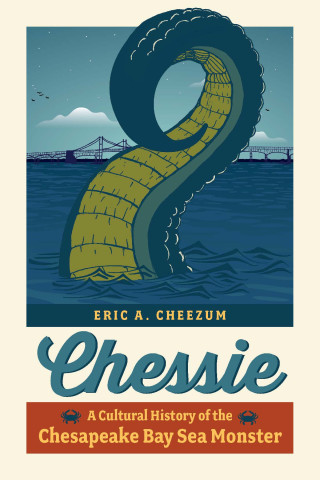Chessie: A Cultural History of the Chesapeake Bay Sea Monster
- By Eric A. Cheezum
- Johns Hopkins University Press
- 288 pp.
- Reviewed by Randy Cepuch
- May 21, 2024
Is Maryland’s creature a marvel or a myth?

Loch Ness has Nessie. Lake Tahoe has Tessie. Lake Champlain has Champ. Canada’s Lake Okanagan has Ogopogo. They’re all “sea monsters” with one thing in common: There’s no clear proof they exist. Similarly, the Chesapeake Bay has Chessie.
Or so some say.
In Chessie: A Cultural History of the Chesapeake Bay Sea Monster, author Eric Cheezum reports that the eponymous creature has (like all the others) been described in many ways by those who’ve claimed sightings: as a big snake, a chain of otters, a seal, a manatee, an optical illusion.
Cheezum, an adjunct history professor at Chesapeake College, offers a different take, repeatedly suggesting that Chessie is a metaphor for the assault on the bay itself by developers who’ve displaced the “watermen” fishing trade that once ruled the area. He submits that “Chessie...was a reflection of another, much more all-consuming monster: the mass migration of people onto the shores of the Chesapeake Bay.”
Several times, he wades further into the dune grass by attempting to tie Chessie sightings to people being gullible because they were so disillusioned with things like the “scandal, anxiety and demoralization that characterized American life at the midpoint of the Carter administration.” These odd and awkward assertions seem heavy-handed and needlessly political, and it’s hard to credit them without considering whether the same things affected the apparent visibility of Nessie, Tessie, Champ, and Ogopogo.
But putting such matters aside, the rest of the book tells some interesting tales. The first modern-day Chessie spotting was off the Virginia coast in summer 1978, on what the author says was otherwise a “slow news day” — which meant it got the media’s attention. Two years later, sightings were reported near Kent Island, Maryland, which is where the mysterious creature has mostly (and allegedly) hung out since.
These days, we might say, “Pics, or it didn’t happen.” Of course, no one had cellphones back then, and security cameras were far from ubiquitous, so it’s not surprising that documentation of those sightings is iffy — and it doesn’t help that some sources seem a bit suspicious. There’s a 1980 sketch, blurry snapshots from 1981, and even a video from 1982 (but the original footage was lost, and the quality of an existing copy is so bad that few experts agree on what, if anything, it shows).
Questionable sourcing notwithstanding, tourism promoters soon saw Chessie as an opportunity. There was no definitive proof that the creature was unfriendly (or anything else), so why not embrace it as the bay’s ambassador?
By summer 1984, Maryland legislators tried to propose a bill to protect Chessie, noting that up in British Columbia, someone had posted a $1 million bounty on Ogopogo, dead or alive. The pols cleverly bypassed the lack of proof of Chessie’s actual existence by asking, “What if it’s the only one?” An opponent of the endeavor observed, “If we find out what it is, we may really not want to protect it. We may want to get rid of it.” The bill failed to make it out of committee.
Meanwhile, the U.S. Fish and Wildlife Service put together a Chessie coloring book that proved to be a popular way to educate kids about the Chesapeake’s ecosystems, and resourceful charter boats prowled the bay in search of you-know-who, offering dinners and conservation lessons along with their tours.
In the mid-1990s, after Chessie reports had slowed considerably, a former Baltimore Evening Sun reporter who’d written several articles about the creature and who claimed a sighting of his own considered attempting a “just the facts” book. He didn’t — and Cheezum’s reference to it is a bit confusing, especially since it’s toward the very end of his own book:
“The prospect of a ‘just-the-facts’ book about Chessie, stripped of all the hoopla, is a noble goal, but an impossible one. To begin with, no one really knows what people actually saw on the water, and what they reported was infuriatingly variable, both in content and reliability. Eyewitness accounts were often not very detailed and either diverted wildly from the ‘classic’ serpent description or replicated it so slavishly that they smacked of perception bias.”
Well, yes. Yet Cheezum has now, decades later, written such a book anyway, finally bringing together the various accounts and suppositions and promotional efforts, and presenting them in a single worthy, well-researched work. Over those decades, scientific confirmation has emerged that one of the unlikely descriptions of Chessie turned out to be well-founded for a charming and enduring reason nicely recounted here. (You’ll have to read the book to find out what it is.)
That said, it’s somehow always the way with sea monsters that reliable evidence is thin. So, if you find yourself anywhere near the Chesapeake Bay this summer and see an unusual creature in the water, don’t spend time blaming politicians. Instead, take good pictures — lots of them!
Randy Cepuch is a member of the Independent’s board of directors. He has seen and photographed fins poking along in a cove near St. Michaels, Maryland, and believed them to be sharks (not impossible in the bay), only to learn later that they were playful cownose rays.
